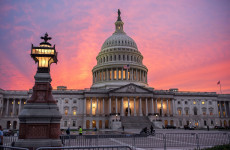Business
US Government Shuts Down as Funding Talks Collapse

The US government has officially shut down after lawmakers failed to reach an agreement on a funding plan before the midnight deadline on September 30, 2023. The impasse arose primarily from disagreements over health care funding, with Democrats advocating for significant investments in programs like Obamacare, while Republicans pushed for a temporary funding extension without these provisions. This marks the first government shutdown since January 2019.
The shutdown is expected to impact approximately 750,000 federal workers, many of whom will be furloughed without pay. President Donald Trump, who has placed blame on Democrats for the stalled negotiations, indicated that his administration might take drastic measures, including mass public sector job cuts, to assert control during this period. “We’d be laying off a lot of people that are going to be very affected. And they’re Democrats,” Trump stated during a press conference at the White House.
Efforts to secure a short-term funding resolution had intensified in the days leading up to the shutdown. The Senate’s last-ditch attempt to pass a funding measure, which had already gained approval in the House of Representatives, ultimately failed. The 100-member Senate requires a minimum of 60 votes for funding bills, a threshold that Republicans, who hold a slim majority, could not achieve due to Democratic opposition.
Political Landscape and Implications
The current political environment has left Democrats, who are in the minority in both chambers, eager to leverage their influence eight months into Trump’s second term. The administration has been characterized by significant changes, including the dismantling of various government agencies. The anxiety in the federal workforce has been exacerbated by recent layoffs conducted by the Department of Government Efficiency, led by entrepreneur Elon Musk.
Trump’s proposed funding measures have been met with skepticism, particularly his request for a temporary extension of funding until late November. Democrats have demanded the restoration of billions in health care spending, specifically targeting the Obamacare health insurance program, which Trump’s administration is expected to eliminate.
As the shutdown takes effect, essential government functions such as the military, the Postal Service, and welfare programs will remain operational. However, the Congressional Budget Office estimates that up to 750,000 workers could be sent home each day, leading to significant financial strain as they await resolution.
Future Negotiations
The Senate is scheduled to reconvene on October 3, 2023, following a brief recess, but the House will remain out of session for the week. This limits the Senate’s ability to expedite any potential agreements. Furthermore, the Senate will be closed on October 4 for the Jewish holiday of Yom Kippur, potentially delaying further negotiations.
Historically, the US government has faced shutdowns 21 times since the modern budget process began in 1976. While some shutdowns have lasted only a few hours, the longest occurred during a standoff over border wall funding in December 2018, lasting 35 days and affecting hundreds of thousands of federal workers.
As negotiations continue, the future of federal funding remains uncertain, with the potential for prolonged disruption affecting workers and services nationwide.
-

 Top Stories3 months ago
Top Stories3 months agoTributes Surge for 9-Year-Old Leon Briody After Cancer Battle
-

 Entertainment4 months ago
Entertainment4 months agoAimee Osbourne Joins Family for Emotional Tribute to Ozzy
-

 Politics4 months ago
Politics4 months agoDanny Healy-Rae Considers Complaint After Altercation with Garda
-

 Top Stories4 months ago
Top Stories4 months agoIreland Enjoys Summer Heat as Hurricane Erin Approaches Atlantic
-

 World5 months ago
World5 months agoHawaii Commemorates 80 Years Since Hiroshima Bombing with Ceremony
-

 Top Stories3 months ago
Top Stories3 months agoNewcastle West Woman Patricia Foley Found Safe After Urgent Search
-

 Top Stories5 months ago
Top Stories5 months agoFianna Fáil TDs Urgently Consider Maire Geoghegan-Quinn for Presidency
-

 World5 months ago
World5 months agoCouple Convicted of Murdering Two-Year-Old Grandson in Wales
-

 World5 months ago
World5 months agoGaza Aid Distribution Tragedy: 20 Killed Amid Ongoing Violence
-

 World5 months ago
World5 months agoAristocrat Constance Marten and Partner Convicted of Infant Murder
-

 Top Stories4 months ago
Top Stories4 months agoClimbing Errigal: A Must-Do Summer Adventure in Donegal
-

 Top Stories4 months ago
Top Stories4 months agoHike Donegal’s Errigal Mountain NOW for Unforgettable Summer Views








